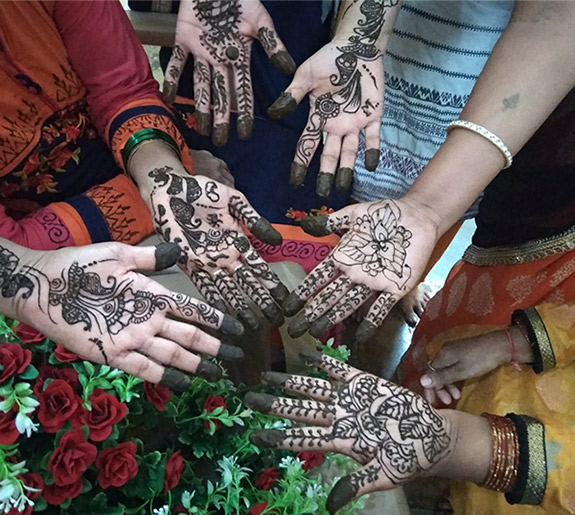Mehndi: Ancient Body Art
August 14, 2019
Mehndi is a form of body art that can be traced back to ancient India. Using a paste made from the powdered leaves of the henna plant, designs are painted onto the skin by squeezing the paste out of a small cone. This leaves a temporary stain that can range from pale orange to deep bronze depending on the henna and the length of time the paste is left on before being washed away.
It is a popular art form in India and other parts of South Asia, as well as areas in the Middle East and Africa. In India, most mehndi consumers are women who decorate their hands or feet, but for some ceremonies men can also use it, perhaps decorating their arms, legs or backs.
Weddings just would not be complete without mehndi. It is very traditional in Hindu, Sikh and Muslim cultures for a bride to have a mehndi party the day before the marriage. Not only the bride but close women relatives and friends get henna applied - although etiquette dictates that the bride's designs should be most elaborate. Aside from weddings, mehndi can be applied for other special occasions and festivals...or just for fun!
Designs can be very simple or beautifully ornate, ranging from simple circles and capped fingers to intricate flowing designs. They typically incorporate traditional Indian designs such as birds, flowers, vines, and auspicious symbols. For brides, the mehndi design often incorporates the groom's name in the pattern. Special designs have been developed for both Hindu and Muslim festivals which include meaningful motifs.
Mehndi used to be art mothers taught their young daughters. It has evolved into a professional craft with certificate courses, apprenticeships, and successful businesses. Young women - including a MarketPlace artisan's daughter - have made a lucrative living providing this service.
SHARE decided to have a mehndi session at the Arpan and Ekta cooperatives. These cooperatives are near each other in Thane, which is about 30 km from the MarketPlace offices. Traditionally mehndi parties have been special times for women when they can escape their everyday chores and enjoy one another's company. Bonding in the artisan groups is very important and contributes to their success and smooth running. This session was clearly a big hit with the women.

"Mehndi conjures up memories of my childhood. We had many mehndi trees around my home and school. My friends and I used to pluck the leaves and grind them on stones. I loved to paint my palms with the orange color and then run to play on the swings. The color got worn off quickly from our playing, so sometimes we would color the palms again. Some days we ended up plucking and grinding the mehndi leaves 3 or 4 times!" -- Sanju Morya (pictured above)

"We have been applying mehndi since we were very young. It is part of our culture and marks different festivals and special occasions. We also have the custom of applying alta, a different red dye, on the feet for happy occasions. For this reason, I always associate mehndi with happiness. My best mehndi memories are connected to the Indian festivals Chhath Puju (dedicated to the Sun and his wife) and Teej (a monsoon festival for women). This session today was a total surprise! We get so busy doing our daily work that we forget how much joy something like applying mehndi to each other can bring. It has been a long time since I applied mehndi and I really enjoyed it." -- Manorama Yadav (not pictured)


"My first memory of applying mehndi was when I was in grade VII and we were celebrating Raksha Bandhan (an Indian festival in which a sister ties a thread to her brother's wrist as a symbol of love and protection). I used to really love doing it and as a young girl, I would have been happy to do it every day. I lost my enthusiasm when I burned my hand. After that, I only applied it for customary occasions. However, I really enjoyed the session today and recaptured the happiness I used to feel." -- Kalpana Chikne (pictured above)

"I have loved mehndi patterns since I was a little girl. We did not have access to mehndi trees, so it was only bought for festivals or other special occasions. So instead I would make a substitute from sugar and tea leaves, boiling them in a pan with water until most of the water was gone leaving a paste behind. I would then use a matchstick or twig to draw different patterns on my palms. When I was younger I had very long hair, and I loved to decorate my hair with flowers (especially jasmine) and apply mehndi. I still like to do this, particularly during the festivals of Ganpati (for the god Ganesh) and Raksha Bandhan." -- Akshada More (pictured above)

"Mehndi is applied all over the hands and feet for weddings. It is also customary to write the initial or the name of our future husband, hiding it in the details of the intricate pattern. I do not know how to draw many patterns and designs, so I usually draw circles on my hands which is how it was done in the olden days. It is simple but it still looks beautiful. When we celebrate Naga Panchami (dedicated to the snake god) it is also the custom to apply mehndi." -- Sushila Sakhpal (pictured above)

